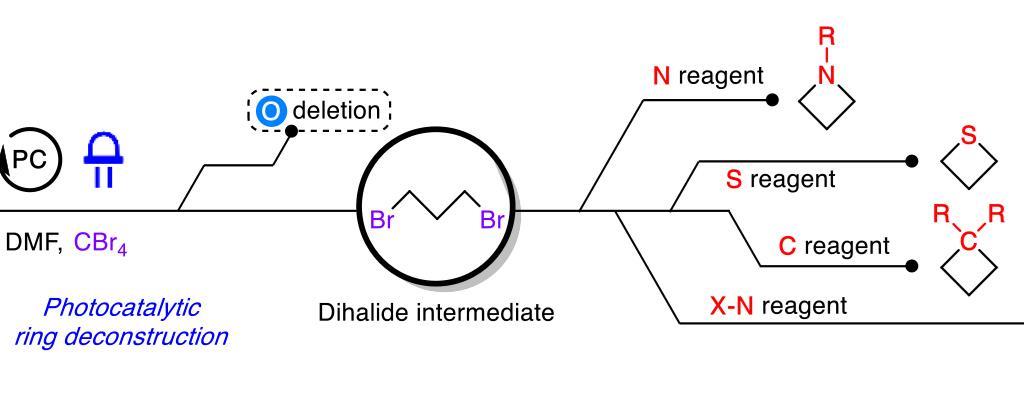Photochemistry provides a pathway to swap the oxygen atom in oxetane rings with nitrogen, carbon or sulfur at a single stroke. The resulting structures, such as azetidines and thietanes, are usually unattainable with traditional reactions and yet…
Blog
-
Just a moment…
Just a moment… This request seems a bit unusual, so we need to confirm that you’re human. Please press and hold the button until it turns completely green. Thank you for your cooperation!
Continue Reading
-
Just a moment…
Just a moment… This request seems a bit unusual, so we need to confirm that you’re human. Please press and hold the button until it turns completely green. Thank you for your cooperation!
Continue Reading
-

Announcing the ROG Falchion Ace HFX ZywOo Edition | ASUS Pressroom
65% compact gaming keyboard features pre-lubed ROG HFX magnetic switches, Rapid Trigger toggle, Speed Tap mode, interactive touch panel, and 8000Hz polling rate
- Battle-tested on the biggest stages: ZywOo’s keyboard of choice during…
Continue Reading
-

Living Brain Study Reveals What Autopsies Miss
Two new research papers from the landmark Living Brain Project at Mount Sinai present what is, by several metrics, the largest investigation ever performed of the biology of the living human brain. The papers present unequivocal evidence…
Continue Reading
-

Robotics Information | AZoRobotics.com – Page not found
Terms
While we only use edited and approved content for Azthena
answers, it may on occasions provide incorrect responses.
Please confirm any data provided with the related suppliers or
…Continue Reading
-

Squeezed at home, US private credit players turn their attention to Europe
The US is the world’s largest private credit market, tripling in size since 2010 (estimated to be around US$1.5 trillion today) and currently more than twice the size of Europe’s market (approximately US$500 billion-US$1 trillion), according to Barings’ report, Direct Lending: Why Global & Why Now?
However, as the US private credit asset class has grown and become more sophisticated, it has also become increasingly competitive. As a result, some US-based private credit funds are exploring opportunities to expand beyond their core US market, with Europe being an attractive first port of call.
Recent macroeconomic developments have contributed to the US-to-Europe private credit push. For one, US funds have had to navigate significant shifts in US trade and tariff policy throughout 2025. As a result, some US investors have sought to diversify and expand their exposure to European private credit to counterbalance volatility on the domestic front.
Another factor has been diverging interest rate trajectories in Europe, where the European Central Bank has cut rates eight times since June 2024. Meanwhile, the US Federal Reserve (the Fed) cut rates by a quarter-point at its mid-September 2025 meeting, its first rate cut since 2024. Some pundits are predicting two further rate cuts before the end of this year, though Fed Chair Jay Powell has cast some doubt on those forecasts.
Besides these recent trends, US funds have also been drawn to Europe’s strong, long-term fundamentals.
Looking further afield
Barings’ analysis highlights how the growth in the private credit asset class alone has been a key contributor to US investors looking beyond the US market.
Ten years ago, private credit was seen by many as a niche strategy, comprised almost exclusively of mid-market direct lending, mezzanine finance and distressed lending. At that time, institutional investors deploying capital into private credit were predominantly US-based, with allocations limited to around 1% of alternative investment programs.
Today, Barings estimates that LP allocations to private credit may be as high as 20% of overall alternative asset portfolios. These allocations span a broader range of investment strategies and regions, with managers and LPs more focused on building global private credit strategies that can maximize relative value across various jurisdictions at different points in the investment cycle.
The fact that private credit allocations have grown so expansively, coupled with a more sophisticated, globally-oriented investor base, are major drivers propelling the leap from the US to Europe.
The growth of the US market has also led to more intense competition for private credit fundraising and deals. Barings estimates that around 500 new entrants have launched in the US during the past five years. This growth in new market participants has coincided with US deal flow consolidating around a smaller cluster of larger, established managers. While the European private credit market is very active, with a number of long-established players, it still lags behind the US in terms of overall size and number of funds.
This consolidation of activity in the US has compelled participants to turn their attention to growth opportunities in Europe, which presents attractive underlying fundamentals. A report by global asset manager Apollo, The Continental Shift: Europe’s Private Credit Moment, identifies Europe as one of the fastest-growing private credit markets, with the potential to reach the same size and scale as its US counterpart.
Apollo notes the promising growth runway for European private credit, with the non-bank lending share of the market in Europe and the UK lagging behind the US. Simultaneously, as reported by Apollo, increasing pressure from European banking regulators may cause banks to retreat from certain lending activities. If that comes to pass, those activities are expected to transition to private credit channels, increasing Europe’s addressable market.
Likewise, Apollo’s report states that capital markets reforms in the EU are creating opportunities for private credit funds to operate in new areas, such as asset-backed financing. Additionally, Apollo notes that European direct lending deals can present private credit dealmakers with between 25-50 basis points of spread enhancement as compared to US equivalent deals.
Navigating nuance
For US stakeholders looking to set up and grow a presence in Europe, it is important to appreciate the key differences between these regions’ private credit markets.
The European market is more of a patchwork than the US, comprised of a multitude of distinct jurisdictions with their own legal and tax regimes and market dynamics, and where private credit is at different levels of maturity. The ability to navigate individual countries’ regulatory nuances and local market conditions is therefore crucial.
Structuring a private credit deal in Europe also involves technical details that US managers must become familiar with. US managers, for instance, are often surprised to find that European documents are looser and more permissive in certain respects than their US equivalents. For example, in US documents, lenders will be accustomed to taking security over substantially all assets, with limited exclusions and carve-outs. In Europe, lenders will usually take a security package that includes share pledges over a “single point of enforcement” as well as other “material companies,” but will not have the same level of hard asset security covered in US documents.
These differences reflect distinctive approaches to restructuring across the two regions. In Europe, lenders tend not to rely on enforcing asset-level security, as this can be slow and value-destructive, typically involving multiple local insolvency processes. Furthermore, it can be time-consuming and expensive to take asset-level security across a range of different jurisdictions. Instead, lenders prefer to restructure out-of-court through a share pledge enforcement in a creditor-friendly jurisdiction at the top of the group. By comparison, in the US, it is relatively efficient and cost-effective to obtain security over the vast majority of assets, and, in a US Chapter 11 bankruptcy proceeding, holding security on as many assets as possible provides lenders with certain advantages. Differences in documentation and restructuring regimes will require managers accustomed to US documents to adjust their expectations accordingly.
Other details, including licensing and withholding tax regimes in individual European jurisdictions, must be carefully considered as well.
Opening a pathway to Europe
These technical details can be managed with the right legal advice. Several large US-based franchises have successfully scaled up their European private credit operations in recent years, offering a blueprint for other managers looking to enter Europe’s private credit market.
The US private credit market remains an attractive and growing space. But expanding into Europe can present managers with valuable opportunities to diversify their exposure and build on already-robust foundations in a solid regional market.
Continue Reading
-

Leaving Windows 10 behind? Apple’s rumored $599 MacBook might be just for you
Kyle Kucharski/ZDNET Follow ZDNET: Add us as a preferred source on Google.
ZDNET’s key takeaways
- Apple could be developing a new budget-friendly MacBook for around $599.
- Rumors state it would house an A18 Pro chipset — the processor found in…
Continue Reading
-

Longevity Gene From Supercentenarians Counters Progeria
A new breakthrough in a rare genetic disease which causes children to age rapidly has been discovered using ‘longevity genes’ found in people who live exceptionally long lives – over 100 years old. The research, by the University of Bristol…
Continue Reading
-

2025 World Gymnastics Championships – Japan’s Oka Shinnosuke: ‘If I can beat Hashimoto Daiki, I can win on the world stage’
Oka Shinnosuke: ‘It’s about me’
Time has flown since last summer for Oka, who stormed to three gold medals in his Olympic debut at Paris 2024 in the all-around, horizontal bar and the team event, which he won alongside Hashimoto. He also took…
Continue Reading
